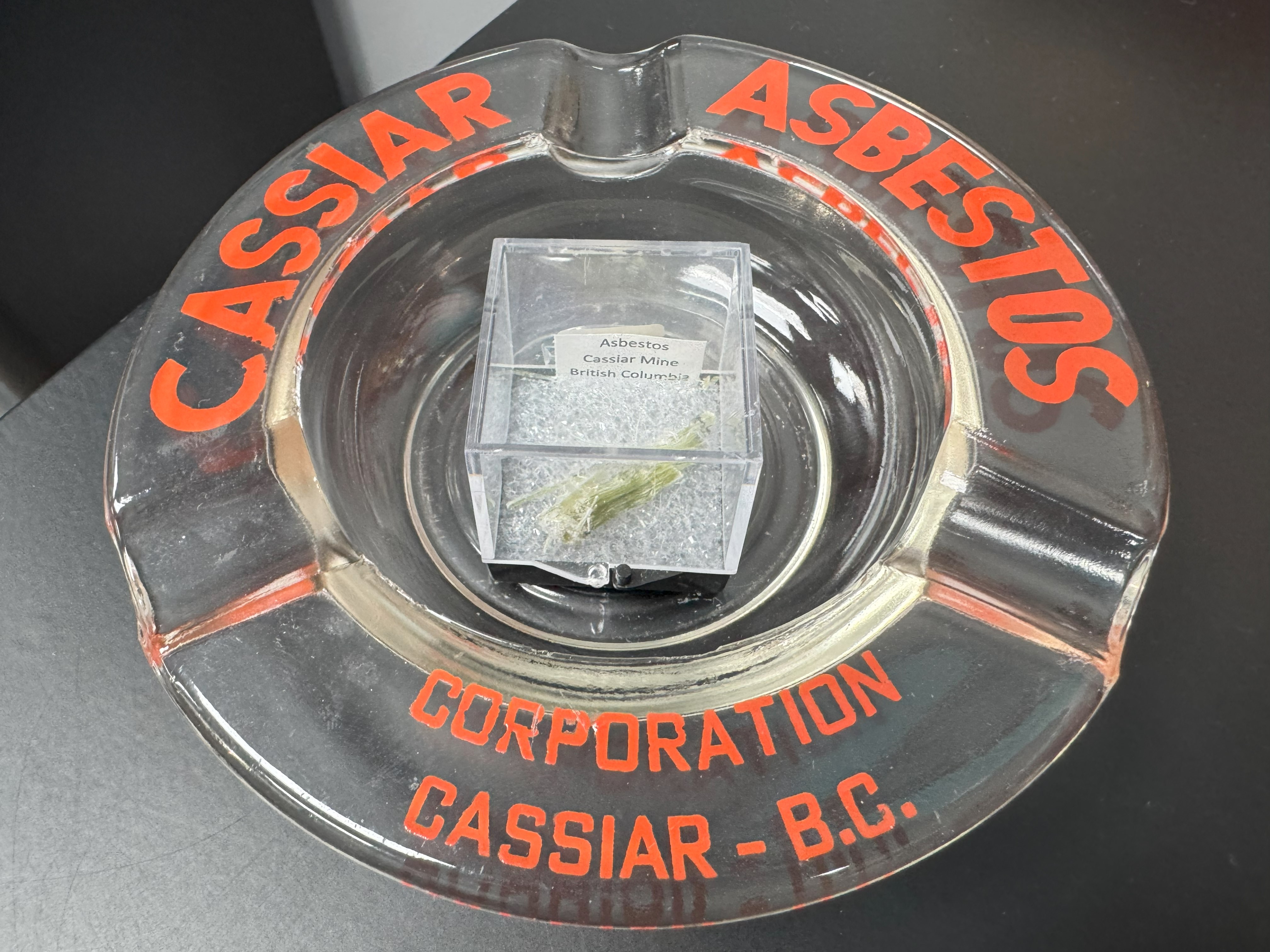
This artifact — a promotional ashtray from the Cassiar Asbestos Corporation paired with a raw asbestos sample from the Cassiar Mine in British Columbia — stands as a poignant relic of a time when asbestos was not only accepted but celebrated as a cornerstone of industrial progress. It encapsulates the duality of an industry that once thrived on the promise of innovation but left behind a legacy of environmental and human health devastation.
The Cassiar Asbestos Mine, nestled in the remote northern reaches of British Columbia, was one of Canada’s most prominent chrysotile asbestos mining operations. Established in the early 1950s, the mine was a key player in the global asbestos trade, supplying the mineral to manufacturers worldwide. Asbestos was marketed as a “miracle material,” prized for its fireproofing, insulating, and industrial applications.
Cassiar was more than just a mine—it was a company town. Built entirely around the mining operation, the town featured housing, schools, recreational facilities, and infrastructure to support the workers and their families. At its peak, the mine employed hundreds of workers, many of whom were exposed daily to airborne asbestos fibers, often without adequate protective measures. The mine operated for over four decades before closing in 1992, a victim of declining global demand and growing awareness of the severe health risks associated with asbestos exposure.
The glass ashtray, emblazoned with the words “Cassiar Asbestos Corporation – Cassiar, B.C.,” is a striking example of mid-20th-century industrial marketing. Such promotional items were commonly distributed by corporations as gifts to suppliers, business partners, and government officials, symbolizing the company’s pride in its operations.
The irony of an asbestos-branded ashtray is glaring to modern observers. Both smoking and asbestos exposure are now well-documented health hazards, with synergistic effects that dramatically increase the risk of lung cancer. This artifact, once a token of corporate goodwill, now serves as a chilling reminder of the industry’s disregard for the health implications of its products.
Accompanying the ashtray is a small sample of raw chrysotile asbestos, the primary type of asbestos mined in Canada. Known as “white asbestos,” chrysotile was widely used in products ranging from cement and roofing materials to brake pads and insulation. The fibrous structure of the sample highlights the very property that made asbestos both useful and deadly. When disturbed, these microscopic fibers become airborne and can be inhaled, embedding themselves in the lungs and causing diseases such as mesothelioma, lung cancer, and asbestosis.
This sample, sourced directly from the Cassiar Mine, is a tangible representation of the mineral’s industrial utility and its devastating health consequences.
The closure of the Cassiar Mine in 1992 did not mark the end of its impact. Decades later, the site remains an environmental hazard. Massive tailings piles—mountains of asbestos-contaminated waste—continue to release fibers into the air and surrounding environment, posing ongoing risks to wildlife and nearby communities.
For former workers and residents, the mine’s legacy is deeply personal. Many have suffered from asbestos-related diseases, which often manifest decades after exposure. The long latency period of these illnesses, combined with the widespread use of asbestos in the mid-20th century, has resulted in a global health crisis that continues to unfold. Efforts to contain and remediate asbestos waste at sites like Cassiar are ongoing, but the scars left by the industry are far from healed.
This ashtray and asbestos sample are more than just artifacts—they are symbols of an era when industrial progress was pursued at any cost, often at the expense of human and environmental health. They reflect the contradictions of the asbestos industry: a material once heralded as a technological marvel but later condemned as a public health disaster.
Artifacts like these serve as powerful reminders of how industries can shape public perception, often obscuring the dangers of their products until scientific evidence and public advocacy bring the truth to light. The Cassiar Asbestos Mine and its promotional relics stand as a testament to the need for vigilance in balancing industrial innovation with ethical responsibility and public safety.